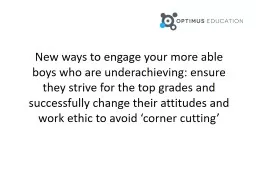PPT-New ways to engage your more able boys who are underachieving: ensure they strive for
Author : alida-meadow | Published Date : 2018-03-12
30 Ideas Ruth Powley wwwlovelearningideascom Change attitudes with powerful data 1 Use standardised scores 2 Use a Tracker to incentivise students 3 and track
Presentation Embed Code
Download Presentation
Download Presentation The PPT/PDF document "New ways to engage your more able boys w..." is the property of its rightful owner. Permission is granted to download and print the materials on this website for personal, non-commercial use only, and to display it on your personal computer provided you do not modify the materials and that you retain all copyright notices contained in the materials. By downloading content from our website, you accept the terms of this agreement.
New ways to engage your more able boys who are underachieving: ensure they strive for: Transcript
Download Rules Of Document
"New ways to engage your more able boys who are underachieving: ensure they strive for"The content belongs to its owner. You may download and print it for personal use, without modification, and keep all copyright notices. By downloading, you agree to these terms.
Related Documents














